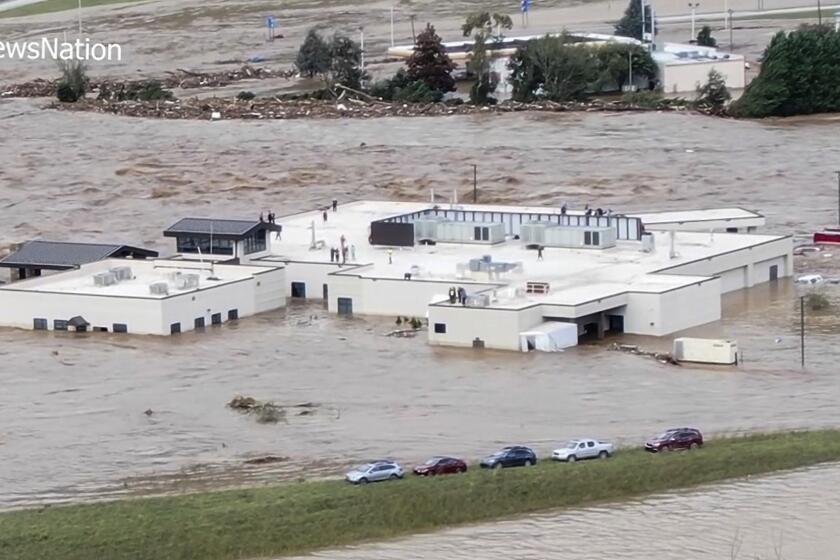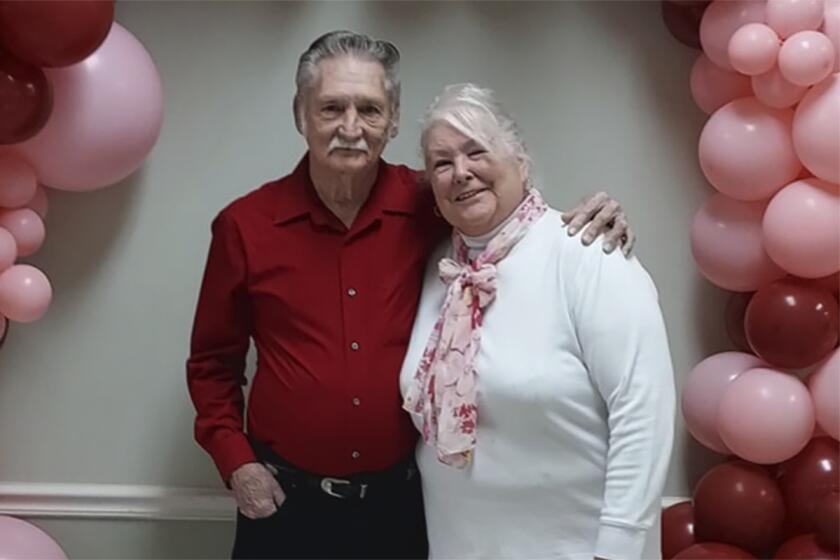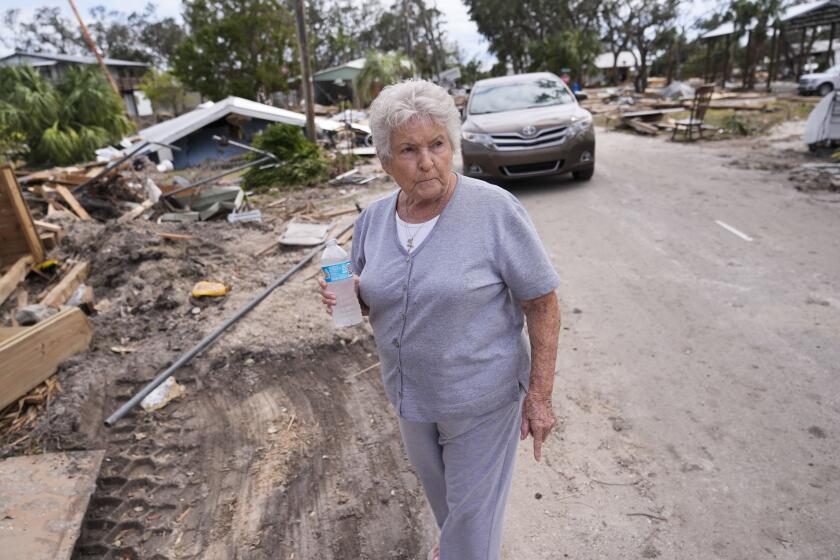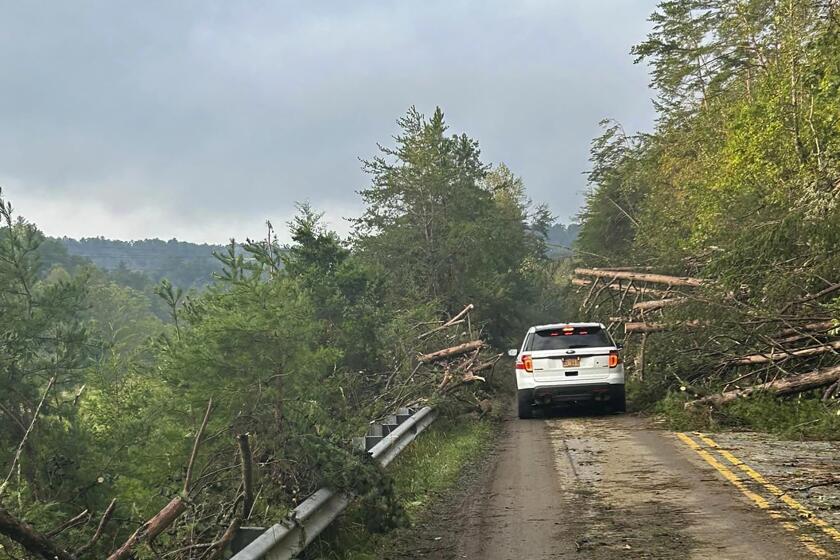Mexican immigrant families plagued by grief, questions after plant workers swept away by Helene
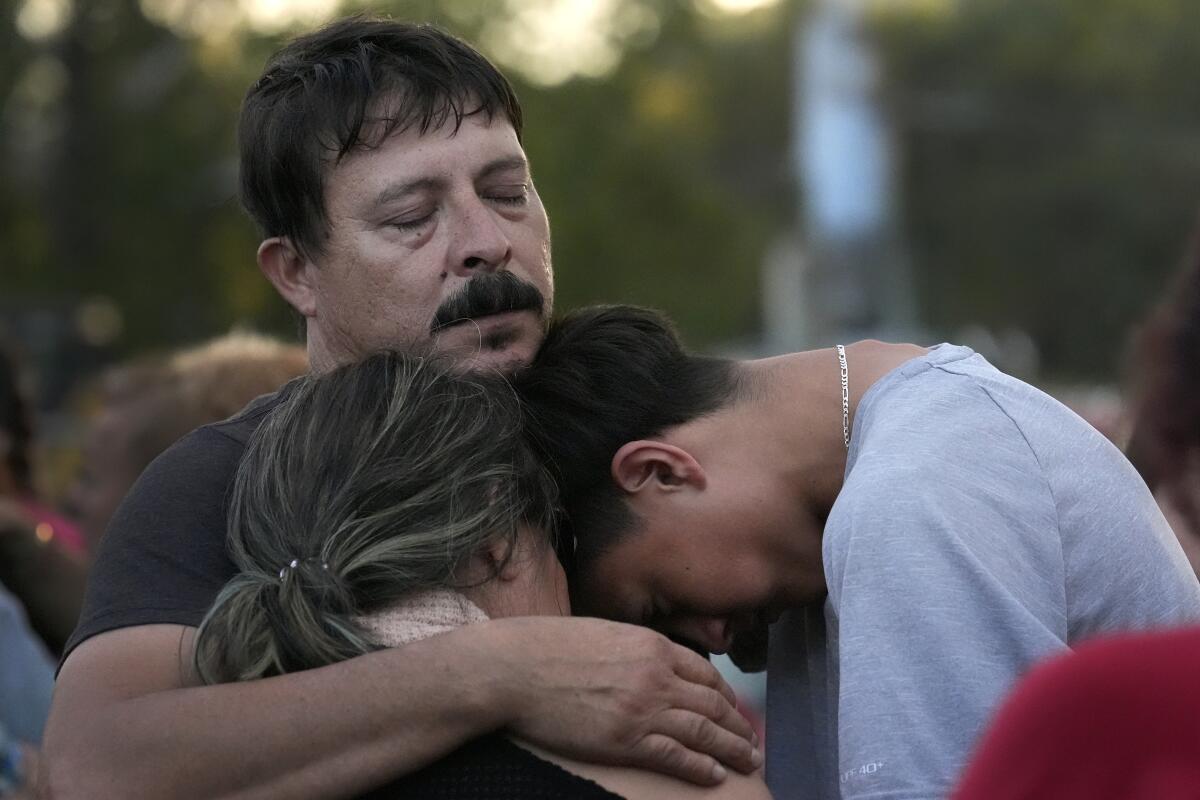
- Share via
ERWIN, Tenn. — With shaking hands, Daniel Delgado kissed a photo of his wife, Monica Hernandez, before lighting a candle in a supermarket parking lot. Family members hugged pictures printed on poster board, some collapsing into them in tears as search helicopters flew overhead in the direction of the hills.
Days after six workers at a plastics factory disappeared under surging floodwaters caused by Hurricane Helene, loved ones and supporters have been gathering for vigils in front of churches, a high school and a grocery store to honor them.
Most nights, prayers in Spanish are spoken over rosary beads: “Mary, mother of Jesus, intercede and help us find them.”
The storm, which claimed the lives of at least 230 people across six states, quickly overwhelmed Erwin, an Appalachian town of around 6,000, on Sept. 27. More than 50 people had to be rescued by helicopter from the roof of a submerged hospital.
The scar it left behind has been especially devastating within the small Latino community that makes up a disproportionate number of workers at the factory: Four of the six workers swept away were Mexican American.
Tennessee authorities are looking into the company behind a plastics factory where 11 workers were swept away by flooding from the remnants of Hurricane Helene.
Two state investigations have been launched into Impact Plastics and whether the company should have done more to protect workers as the danger grew.
The families of those lost say they still can’t comprehend the ferocity of the storm — or why their loved ones didn’t get out of the factory earlier to avoid the raging floodwaters.
“We ask: Why? Why did she go to work? Why did she stay?” Hernandez’s sister Guadalupe Hernandez-Corona said, through a translator, after a Thursday night vigil. “We’re all still wondering.”
Impact Plastics President Gerald O’Connor has said no employees were forced to keep working and they were evacuated at least 45 minutes before the massive force of the flood hit the industrial park.
“There was time to escape,” he said in a video statement, adding that he was among the last to leave the plant after ensuring everyone was out. The National Guard rescued five employees by helicopter.
But surviving workers say the evacuation began too late. Some clung to pipes on truck flatbeds for up to six hours while making frantic 911 calls and saying goodbyes to loved ones. Some saw co-workers carried off by the current.
Jerry and Marcia Savage are among the more than 150 people confirmed dead in Hurricane Helene. Dozens of them died just like the Savages, when trees fell on homes or cars.
Emergency dispatchers said resources were spread thin as a rescue operation was underway over a mile downriver at Unicoi County Hospital.
Normally running 2 feet deep, the Nolichucky River rose to a record 30 feet that day, running at more than 1.4 million gallons per second, which is twice as much as Niagara Falls.
The plastics plant was open, even as schools closed. Robert Jarvis, who began his shift at 7 a.m., said employees continued to work while receiving phone alerts about possible flooding. Many stayed even after management asked them to move cars because 6 inches of water had accumulated in the parking lot.
Employees were finally told to evacuate after the power went out and when the water was about a foot high, he said. Jarvis said he survived only because he was pulled into the bed of someone’s lifted truck, which labored up an all-terrain road for three hours.
Jarvis said the six lost co-workers were “like family,” and he feels a responsibility to them to share his experience.
“They shouldn’t have been at work that day,” he said. “None of us should have.”
Massive rains from powerful Helene left people stranded, without shelter and awaiting rescue around the U.S. Southeast.
Annabel Andrade, whose cousin’s daughter Rosy Reynoso is still missing, said evacuation routes were insufficient. And O’Connor’s statement angered her: “He left safely. Why was he able to save himself and leave these other employees stranded?”
Alma Vazquez, a Catholic Charities case manager who met some of the lost workers decades ago after she first made her home in Erwin at a migrant farm camp, said the deaths were “completely preventable.”
“People didn’t have to die at the place where they work,” she said.
Many of the victims had deep ties to Erwin. It is more than 90% white with around about 8% of the population, around 500 people, identifying as Hispanic in 2022 up from 3.8% a decade earlier, according to Census Bureau figures.
Lidia Verdugo, Bertha Mendoza and Hernandez, all Mexican Americans, lived in the community for two decades. Hernandez began working at Impact Plastics shortly after arriving, her sister said.
The most recent arrival to Erwin, eight years ago, was 29-year-old Rosy Reynoso. She and her husband had just moved into their own apartment after living with her mother, whom she still visited daily. Her 10-year-old son is in Mexico, and she was working to bring him here, Andrade said.
Two white plastics workers, Sibrina Barnett and Johnny Peterson, were also swept away.
At least 121 deaths in six Southeastern states have been attributed to the storm, a number that climbed Monday as a clearer picture emerged of the damage.
There has been frustration in the Latino community over the fact that state officials did not immediately send translators to assist survivors of the disaster, and families became more upset when workers answering phone lines for missing persons tips spoke only English.
When a Tennessee Emergency Management Agency director was asked why these resources weren’t available until over a day into the search, he said they hadn’t been aware of the size of the Spanish-speaking population in the area.
“For them, it was very heartbreaking to hear that,” said Ana Gutierrez, an organizer with the Tennessee Immigrant and Refugee Rights Coalition who has been assisting families.
Gutierrez also said families felt their plight had been overshadowed by the hospital rescue, which made news the day it happened while the plant workers did not.
Some comfort has been found at nightly vigils, where people prayed in both Spanish and English and lit candles as the names of the workers were read.
Erwin Mayor Glenn White said he was moved to see the crowd, a mix of Latino and white residents, coming together in solidarity and grief.
“We are one people. Our country’s motto says that, ‘Out of many, come one,’” White said.
Hurricane Helene’s death toll topped 200 on Thursday and could rise higher still, as searchers make their way to places that are hardest to reach.
At Saint Michael The Archangel, where the vast majority of the 225 parishioners are Latino, families gather to comfort each other and eat Mexican pozole as donations of water, food and other supplies were delivered.
Andrade’s family was one of the first Latino families to settle in Erwin in the 1980s. When her 19-year-old son died in 2017, she became the first in the community to lay a family member to rest here, in the cemetery next to Saint Michael, instead of sending the body back to Mexico for burial.
Reynoso’s husband, who remains hopeful her body will be found, initially planned to inter her in Mexico but later decided her body, if found, will stay in Tennessee. “You’ve made a life here — your family’s going to be here,” Andrade told him. “This is your home.”
Engraved Spanish prayers adorn the cemetery’s tombstones, which Andrade sees as a symbol of the life Latino immigrants have made in America.
“It’s a way to keep them with us,” she said.
Willingham writes for the Associated Press. Associated Press journalists Kimberlee Kruesi in Nashville and Ben Finley in Norfolk, Va., contributed to this report.
More to Read
Sign up for Essential California
The most important California stories and recommendations in your inbox every morning.
You may occasionally receive promotional content from the Los Angeles Times.
